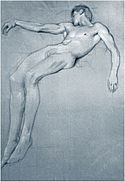This is an old revision of this page, as edited by Ujj778 (talk | contribs) at 05:14, 22 July 2018 (解除しろ、Ujj778の日本語アカウントブロックを解除しろってば。). The present address (URL) is a permanent link to this revision, which may differ significantly from the current revision.
Revision as of 05:14, 22 July 2018 by Ujj778 (talk | contribs) (解除しろ、Ujj778の日本語アカウントブロックを解除しろってば。)(diff) ← Previous revision | Latest revision (diff) | Newer revision → (diff){{Infobox Artwork | image_file=Herbert Draper - The Lament for Icarus - Google Art Project.jpg | title=The Lament for Icarus | artist=Herbert James Draper | year=identifies Icarus "with the other heroes of the Pre-Raphaelites and symbolists, who, like James Dean half a century later, manage to live fast, die young and leave a beautiful corpse".
The composition

In 1890s Draper was focused mainly on ancient Greek mythological subjects. Frederic Leighton had depicted Icarus in 1869, but while Leighton showed the preparations for the flight, Draper depicted the tragic ending of the flight. For the composition Draper adopted Leighton's method of depicting separate figures, for which he employed four young professional models (Ethel Gurden, Ethel Warwick, Florence Bird and Luigi di Luca).
The use of the male body as a vehicle for the projection of subjective emotion, as in The Lament for Icarus, is a feature of late-Victorian painting and sculpture, and in The Lament for Icarus the body appears to melt within the arms of one nymph. Draper applied liquid light effects without abandoning form and used mainly warm colors. The tanned skin of Icarus refers to his close approach to the Sun before falling down. The rays of the setting sun on distant cliffs emphasize the transience of time. Moralizing, sentimental and sensual, The Lament for Icarus ultimately became a well-composed image of epic failure. However, somewhat surprising, Icarus has his wings fully intact, contrary to the myth where the wax melted and Icarus fell flapping his bare arms. The image of a "winged creature" is likely utilized to create a more symbolic, romantic and elegant appearance.
Notes
- Cite error: The named reference
Nyenhuiswas invoked but never defined (see the help page). - ^ Alison Smith. Exposed: The Victorian Nude, Watson-Guptill, 2002
- Ovid. "Daedalus et Icarus." Metamorhposes.